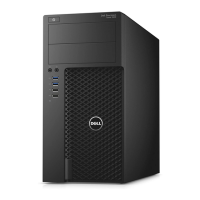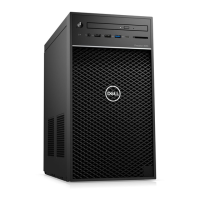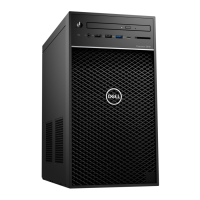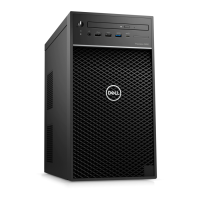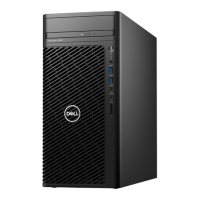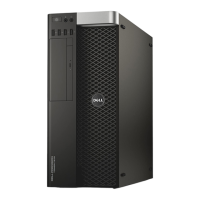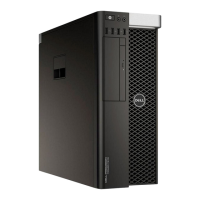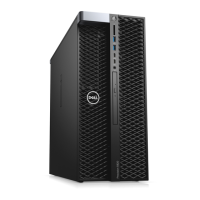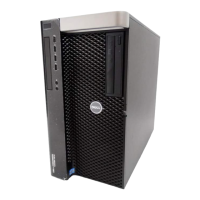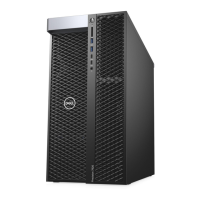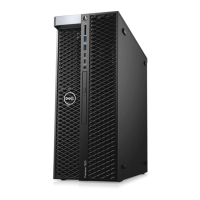Do you have a question about the Dell Precision Tower 3420 and is the answer not in the manual?
Guidelines to protect your computer from potential damage and ensure personal safety.
Steps to perform before starting any internal work, including turning off the system.
Lists tools required for component removal and installation procedures.
Steps for removing and installing hard drives and optical drives.
Procedure for removing and installing memory modules and processors.
Procedure for removing and installing the computer's main system board.
Configuring the order in which the computer attempts to find an operating system.
Overview of general options available in the System Setup utility.
Recommended procedure for updating the system's BIOS.
Information on setting, changing, and disabling system and BIOS passwords.
Detailed explanation of the ePSA diagnostics for comprehensive hardware checking.
Interpreting power LED states for troubleshooting hardware problems.
List of common error messages and beep codes for system issues.
Technical specifications for the computer's processor and memory modules.
Key system information including chipset, BIOS, and expansion bus details.
Description of all external ports and connectors on the computer.
Specifications regarding the computer's power supply and physical dimensions.
Guidelines to protect your computer from potential damage and ensure personal safety.
Steps to perform before starting any internal work, including turning off the system.
Lists tools required for component removal and installation procedures.
Steps for removing and installing hard drives and optical drives.
Procedure for removing and installing memory modules and processors.
Procedure for removing and installing the computer's main system board.
Configuring the order in which the computer attempts to find an operating system.
Overview of general options available in the System Setup utility.
Recommended procedure for updating the system's BIOS.
Information on setting, changing, and disabling system and BIOS passwords.
Detailed explanation of the ePSA diagnostics for comprehensive hardware checking.
Interpreting power LED states for troubleshooting hardware problems.
List of common error messages and beep codes for system issues.
Technical specifications for the computer's processor and memory modules.
Key system information including chipset, BIOS, and expansion bus details.
Description of all external ports and connectors on the computer.
Specifications regarding the computer's power supply and physical dimensions.
| Tcase | 71 °C |
|---|---|
| Bus type | DMI3 |
| Stepping | R0 |
| Tjunction | - °C |
| FSB Parity | No |
| Processor cache | 6 MB |
| Processor cores | 4 |
| System bus rate | 8 GT/s |
| Processor family | Intel® Core™ i5 |
| Processor series | Intel Core i5-6500 Desktop series |
| Processor socket | LGA 1151 (Socket H4) |
| Processor codename | Skylake |
| Number of QPI links | - |
| Processor frequency | 3.2 GHz |
| Processor cache type | Smart Cache |
| Configurable TDP-down | - W |
| Processor lithography | 14 nm |
| Processor manufacturer | Intel |
| Processor front side bus | - MHz |
| PCI Express slots version | 3.0 |
| Processor boost frequency | 3.6 GHz |
| Processor operating modes | 64-bit |
| PCI Express configurations | 1x16, 2x8, 1x8+2x4 |
| Thermal Design Power (TDP) | 65 W |
| Number of processors installed | 1 |
| Maximum number of PCI Express lanes | 16 |
| Memory types supported by processor | DDR3L-SDRAM, DDR4-SDRAM |
| Memory voltage supported by processor | 1.35 V |
| Memory clock speeds supported by processor | 2133, 1333, 1600, 1866 MHz |
| Memory bandwidth supported by processor (max) | 34.1 GB/s |
| Maximum internal memory supported by processor | 64 GB |
| On-board graphics card ID | 1912 |
| Discrete graphics card model | NVIDIA® Quadro® K620 |
| On-board graphics card model | Intel® HD Graphics 530 |
| Discrete graphics card memory | 2 GB |
| Discrete graphics memory type | GDDR3 |
| Graphics card Open GL support | Yes |
| On-board graphics card family | Intel® HD Graphics |
| Maximum on-board graphics card memory | 1.74 GB |
| On-board graphics card OpenGL version | 4.4 |
| On-board graphics card base frequency | 350 MHz |
| On-board graphics card DirectX version | 12.0 |
| On-board graphics card dynamic frequency (max) | 1050 MHz |
| Number of displays supported (on-board graphics) | 3 |
| Scalability | 1S |
| Processor code | SR2BX |
| Processor ARK ID | 88184 |
| Processor package size | 37.5 x 37.5 mm |
| Supported instruction sets | SSE4.2, AVX 2.0, SSE4.1 |
| Thermal solution specification | PCG 2015C |
| Intel Stable Image Platform Program (SIPP) version | 1.00 |
| Memory slots | 4x DIMM |
| Internal memory | 8 GB |
| Memory channels | Dual-channel |
| Memory clock speed | 2133 MHz |
| Internal memory type | DDR4-SDRAM |
| Memory layout (slots x size) | 1 x 8 GB |
| Operating altitude | -15.2 - 3048 m |
| Non-operating altitude | -15.2 - 10668 m |
| Storage temperature (T-T) | -40 - 65 °C |
| Operating temperature (T-T) | 5 - 35 °C |
| Storage relative humidity (H-H) | 5 - 95 % |
| Operating relative humidity (H-H) | 20 - 80 % |
| HDD size | 3.5 \ |
| HDD speed | 7200 RPM |
| HDD interface | SATA III |
| Storage media | HDD |
| Optical drive type | DVD±RW |
| Total storage capacity | 1000 GB |
| Number of storage drives supported | 2 |
| Chassis type | SFF |
| Product color | Black |
| Placement supported | Horizontal/Vertical |
| Headphone outputs | 0 |
| USB 2.0 ports quantity | USB 2.0 ports have a data transmission speed of 480 Mbps, and are backwards compatible with USB 1.1 ports. You can connect all kinds of peripheral devices to them. |
| USB 3.2 Gen 1 (3.1 Gen 1) Type-A ports quantity | 6 |
| Cabling technology | 10/100/1000Base-T(X) |
| Ethernet LAN data rates | 10, 100, 1000 Mbit/s |
| Operating system language | Multilingual |
| Recovery operating system | Windows 10 Pro |
| Operating system installed | Windows 7 Professional |
| Sustainability certificates | ENERGY STAR |
| Audio system | HD |
| Product type | Workstation |
| Motherboard chipset | Intel® C236 |
| Power supply | 180 W |
| Power supply input voltage | 100 - 240 V |
| Power supply input frequency | 50 - 60 Hz |
| Cables included | AC |
| Depth | 292 mm |
|---|---|
| Width | 92.6 mm |
| Height | 290 mm |
| Weight | 5300 g |
